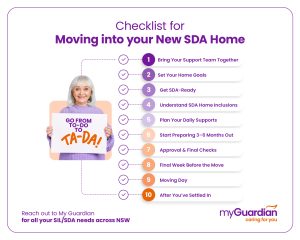Navigating the National Disability Insurance Scheme (NDIS) application process can feel complex, especially if you’re new to the system. This step-by-step guide will help you understand exactly how to apply for NDIS and make the process as smooth as possible.
From eligibility checks to preparing documents and submitting your application, following these steps can help you start your NDIS journey with confidence.
Step 1: Check Your Eligibility
Before you begin learning how to apply for NDIS, it’s important to check if you meet the eligibility requirements. The NDIS is designed to support individuals with disabilities who need assistance with daily living and personal goals. Eligibility requirements include:
-
- Age: You must be under 65 at the time of your application.
-
- Residency: Applicants must be Australian citizens, permanent residents, or hold a Protected Special Category Visa.
-
- Disability Requirements: You need to have a disability that significantly impacts your ability to perform everyday tasks and requires support, or have a condition that is likely to be permanent.
You can quickly check your eligibility on the NDIS website by completing the Access Checklist. This tool can give you a clearer idea of whether you qualify before starting your application.
Step 2: Gather the Necessary Documentation
Once you’ve confirmed your eligibility, the next step in how to apply for NDIS is gathering the necessary paperwork. The application process requires a fair amount of documentation to support your request for funding. Here’s what you’ll need:
-
- Proof of Identity: This may include documents like your birth certificate, driver’s licence, Medicare card, or passport.
-
- Proof of Residency: Providing a utility bill, rental agreement, or other official document showing your Australian residency status.
-
- Evidence of Disability: Medical reports, specialist letters, and assessments that outline your condition, its impact on your daily life, and the support required.
You may need assistance from a healthcare professional to provide details of your condition and confirm that your disability is likely to be permanent. These reports play a critical role in the NDIS decision-making process.
We are here to help.
Request a call back to get your free consultation and ongoing support.
Step 3: Submit an NDIS Access Request Form
The next step in how to apply for NDIS is completing and submitting an Access Request Form. There are a few ways you can obtain this form:
- Contact the NDIS: You can call the NDIS directly on their official helpline and request the Access Request Form.
- Visit an NDIA Office: You can also pick up the form at your nearest National Disability Insurance Agency (NDIA) office.
- Complete Online: If eligible, some applicants may be able to fill out the form online through the NDIS myplace portal.
The Access Request Form will ask for details about your identity, residency, and disability. If your application is being completed on behalf of someone else, make sure to include this information on the form as well.
Step 4: Obtain Supporting Documents from Health Professionals
Providing medical evidence is essential when learning how to apply for NDIS. Your health professionals play an important role in demonstrating the impact of your disability. It’s advisable to contact your GP, specialists, or therapists to write detailed reports addressing your functional capacity and any assistive support you require.
Reports should ideally contain information about:
- The nature of your disability
- How the disability affects daily activities
- The supports you need for daily life or community participation
Ask your healthcare team to be as detailed as possible, including examples of specific tasks that you struggle with. For instance, if you need help with mobility, indicate how your condition impacts your ability to get around independently.
Step 5: Submit Your Application
When you’ve gathered all your documentation and completed the Access Request Form, it’s time to submit your application. There are multiple ways to submit your NDIS application, depending on what’s most convenient for you:
- Phone: Call the NDIS helpline to submit your application by phone. They may ask you to provide details verbally and submit certain documents via email or post.
- Post: You can mail your completed Access Request Form along with your supporting documents to the address provided by the NDIS.
- In-Person: Drop off your application at a local NDIA office. This may be ideal if you want confirmation that everything has been received.
Step 6: Await Confirmation and Attend an Initial Planning Meeting
After you’ve submitted your application, the NDIA will review your request to determine if you qualify for NDIS support. Processing times can vary, but generally, the NDIS aims to respond within 21 days of receiving all required information.
If your application is successful, you’ll be invited to an initial planning meeting with an NDIS planner or Local Area Coordinator (LAC). During this meeting, you’ll discuss your needs, goals, and the types of support that might be suitable. This is also where you’ll start designing your NDIS plan, so it’s a good idea to prepare by thinking about your long-term goals and how you’d like the NDIS to support you.
Step 7: Create Your NDIS Plan
An essential part of understanding how to apply for NDIS is recognising the planning phase. Your NDIS plan is a tailored support blueprint designed to meet your specific goals and needs. During your planning meeting, the planner will work with you to understand what kind of supports you require, covering aspects such as:
- Core Supports: Essential daily activities like personal care, cleaning, and transport.
- Capacity-Building Supports: Services aimed at building skills and fostering independence.
- Capital Supports: Investments in assistive technology or home modifications.
With these supports categorised in your NDIS plan, you can clearly allocate your funding according to what’s most important to you.
Step 8: Implement and Manage Your NDIS Plan
Once your plan is approved, you can start using your NDIS funding to access the supports you need. Your planner will explain how to manage your plan, which can be done in one of three ways:
- Self-Managed: You control your funding, pay for services directly, and then claim reimbursements from the NDIS.
- Plan-Managed: A plan manager helps you handle the financial side of your plan, ensuring payments to providers are managed.
- NDIA-Managed: The NDIA handles payments directly with providers, meaning you won’t need to worry about tracking expenses.
Your choice of management style will depend on your comfort level with managing finances and your ability to coordinate services independently.
Explore our Plan Management Services
Admin and financial assistance to monitor your expenditures and optimise your NDIS funding.
Step 9: Review Your Plan Regularly
After learning how to apply for NDIS, it’s essential to keep in mind that your plan is reviewed annually, or sooner if your circumstances change. This ensures that your NDIS funding remains aligned with your needs. During a review, you can discuss changes to your goals or the supports you need to make adjustments as necessary.
Conclusion
Knowing how to apply for NDIS can unlock a world of support, promoting greater independence and helping you or your loved one achieve personal goals. By following these steps – from eligibility checks and gathering documents to creating a plan and managing your supports – you’ll be well-prepared to begin your journey with the NDIS.
We are here to help
If you need help, contact My Guardian for personalised support. As a registered NDIS provider, we are here to guide you through the process, answer any questions, and help you understand your care options. Visit our Contact Us page, email us at services@myguardian.com.au, or call 02 9336 7555 to connect with one of our friendly professionals today.






